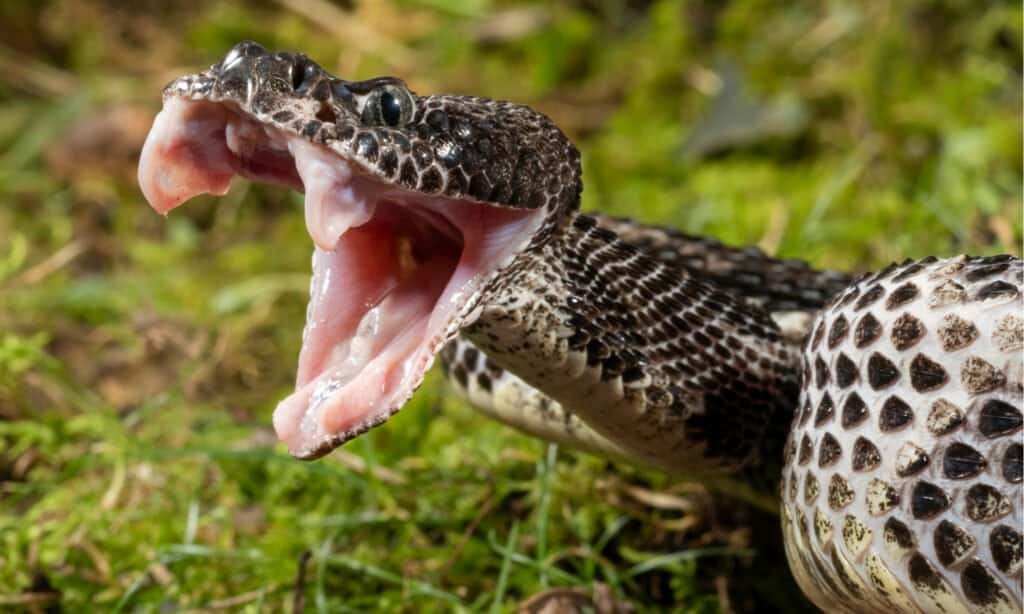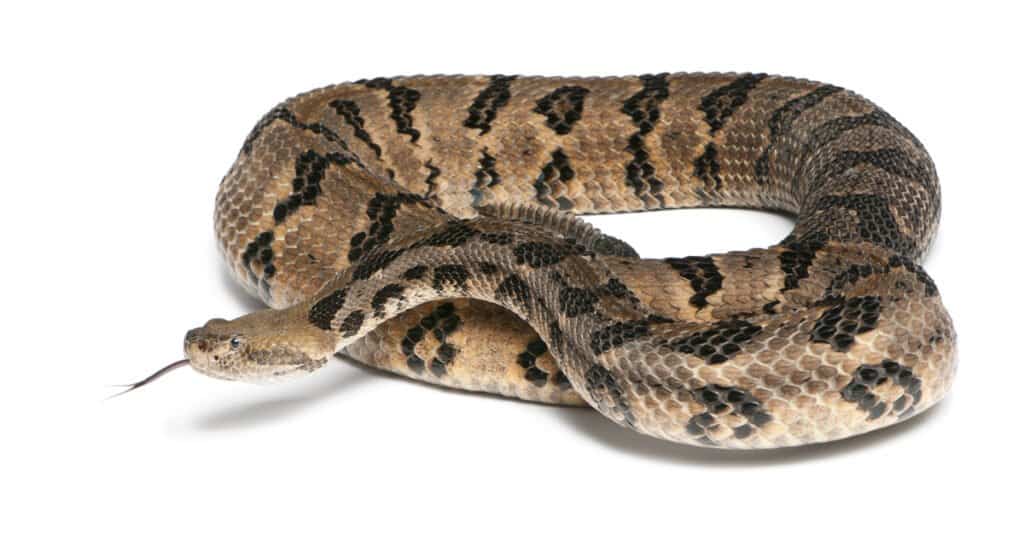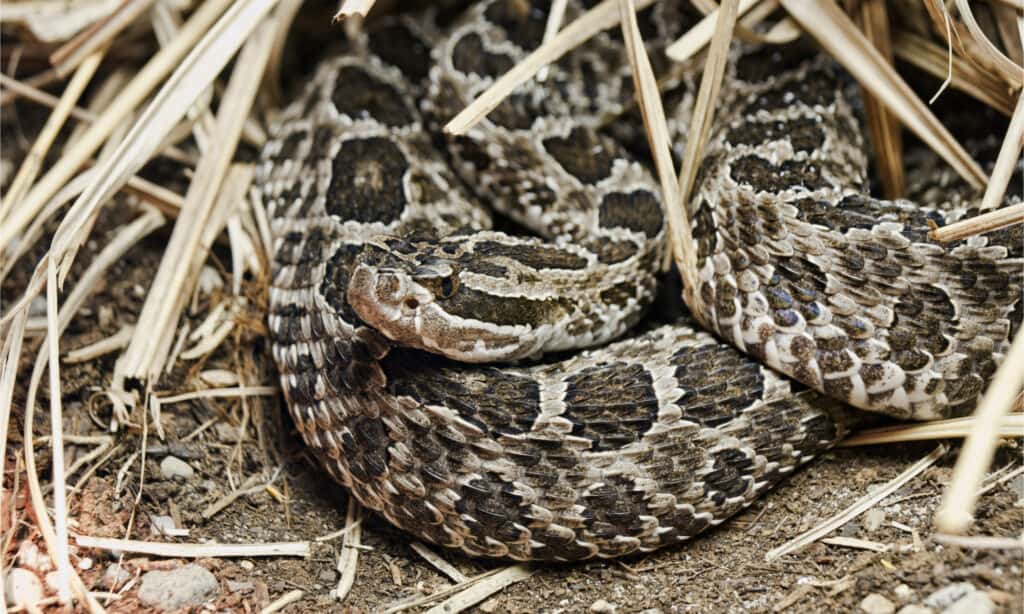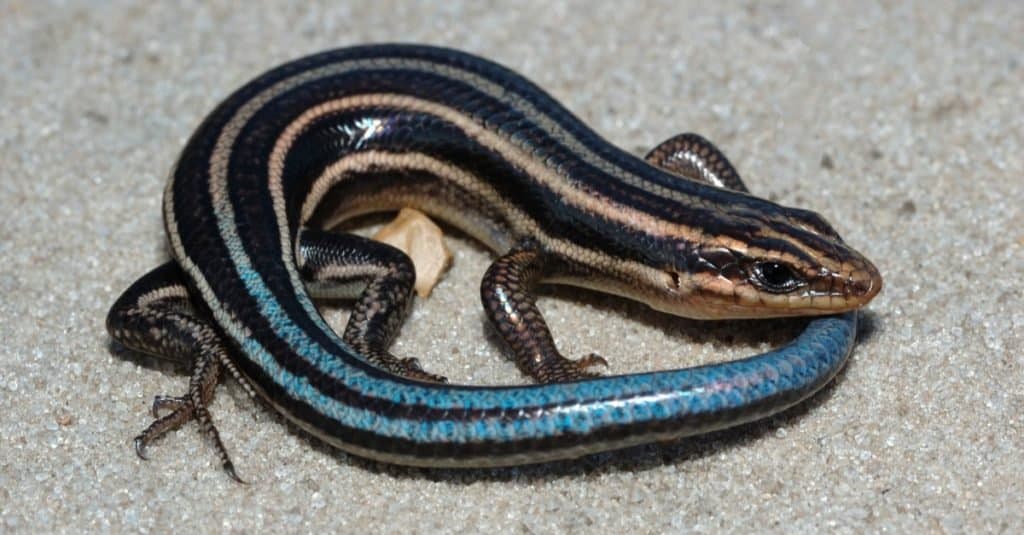Snakes are a valued part of Wisconsin’s wildlife. This summer, Wisconsinites can expect snakes to come out in their numbers. The Wisconsin Department of Natural Resources states that the state is home to 21 species of snakes.
Of this number, 14 are listed as endangered, threatened, or special concern. However, despite the large number of species in the state, Wisconsin only has two dangerous snake species. Coincidentally, both are rattlesnakes! Let’s take a look at Wisconsin’s 2 largest and most dangerous snakes this summer.
Timber Rattlesnakes

Timber rattlesnakes are a species of pit vipers found in parts of Wisconsin.
©Joe McDonald/Shutterstock.com
Also known as canebrake rattlesnakes, timber rattlesnakes are a species of pit vipers. This means they have telltale moveable fangs and a pair of heat-sensing pits located between each of their eyes and nostrils.
They also have rounded heads that are either gray, tan, or yellow, and V-shaped tails. Timber rattlesnakes are an endangered and highly venomous snake species. In Wisconsin and many other states, possessing one is illegal! The mating and reproduction of these snakes are worth noting. Female rattlesnakes mature at 5 years of age and reproduce only once every two or three years. In addition, only a third of female rattlesnakes reproduce more than once. This fact is probably a contributing factor to their endangerment.
After maturity, they pick their partners after they compete in a courtship dance. In this dance, the male rattlesnake first slides right next to the female. He gently rubs his entire body against hers. If all goes well, the male will slide his tail under hers to mate.
Timber rattlesnakes have unique rattlers. They are either yellow or black and add a new segment each time they shed. This happens every one or two years. Timber rattlesnakes often feed on shrews, chipmunks, and mice. They capture their prey by stalking and ambushing them. They strike quickly and inject their venom into their victims. The venom affects their prey’s tissues and cells which makes it easier for timber rattlesnakes to eat them.
Timber Rattlesnake Venom
Timber rattlesnakes are considered one of the most dangerous snakes in North America and Wisconsin. They have long solenoglyphous fangs and high venom yields, making their bites strong enough to kill a human. Luckily, these snakes aren’t quick to bite.
Before striking, timber rattlesnakes make a big show of rattling and feinting. Their venom contains canebrake toxin which causes the quick spread of venom and toxins in their victim’s body. A rattlesnake bite is an emergency and should be treated as one.
How to Identify Timber Rattlesnakes in Wisconsin

Weighing up to 52.3 ounces, timber rattlesnakes are larges venomous snakes.
©Eric Isselee/Shutterstock.com
Timber rattlesnakes are large venomous snakes that are known to measure around 36-60 inches and weigh up to 52.3 ounces in their adult stages.
Timber rattlesnakes can be distinguished by the dark and vertical zig-zag bands set against their gray, brown, or almost pinkish bodies. The species also has an orange or yellow stripe running straight down its back. Several different color morphs are recognized, including a black color morph and a yellow color morph.
Eastern Massasauga Rattlesnakes

Eastern massasaugas are a subspecies of massasauga rattlesnakes found in several parts of Wisconsin.
©DnDavis/Shutterstock.com
Massasaugas (pronounced mass-a-saw-ga) have quite a lot of names. They are known as massasauga rattlesnake (Canada), muck rattler, black massasauga, massasauga rattler (Ontario), black rattler, gray rattlesnake (Iowa), black snapper, little gray rattlesnake, and prairie rattlesnake to name a few.
Eastern massasaugas are a subspecies of massasauga rattlesnakes found in several parts of Wisconsin. These species are endangered, consequently, it is illegal to kill, capture, or trade one in the state of Wisconsin. Massasaugas do not rattle their tails near humans. Several researchers believe that this could be as a result of being hunted. The species realized that rattling their tails only served to alert humans of their presence.
Despite this, eastern massasaugas are known to be docile and shy. They avoid humans and hardly ever bite. When spotted, they try their best to hide or remain motionless in a bid to camouflage or blend into their surroundings. Unlike timber rattlesnakes, massasaugas are polygamous and choose new partners each year. Just like rattlesnakes, females reproduce every two to three years. They are known to feed on small mammals and smaller snakes.
Eastern Massasauga Venom
According to Marissa Laureano and Mark Crowther, researchers and doctors of medicine, the venom of the eastern massasauga is complex. It contains metalloproteinases, L-amino acid oxidase, phospholipase A2 enzymes, and serine proteases.
Victims will experience pain, swelling, and redness. A bite from an eastern massasauga is an emergency and should be treated as one. Reach out to the emergency services as soon as possible.
How to Identify Eastern Massasauga Rattlesnakes in Wisconsin
Eastern massasaugas are gray or light-brown with dark blotches as well as white spots all over their sides and back. Their bellies, on the other hand, are plain black. On average, they are 18.5-30 inches long. Their rattles are a series of interlocking scale segments, which make a buzzing noise when the tail is vibrated.
What To Do If You See a Snake in Wisconsin
If you see a snake in Wisconsin, remember to remain calm. Sudden movements threaten and agitate several snake species. Stay calm and walk away as quietly as you can. Then, put a call through to Wisconsin’s pest control services. Remember that snakes keep the population of several pests in check and are an important part of the ecosystem.
What To Do If You Get Bitten by a Snake in Wisconsin
Contact Wisconsin emergency services immediately if you get bitten by a snake. It is easier to effectively treat a snake bite if it is reported in time. It is also important to sit still and calm. You do not want to help the snake’s venom circulate by moving around a lot.
Do not cut off the bitten part or try to suck the venom out as you could worsen the situation. Stay calm and remember that there have been only two verified deaths in Wisconsin from rattlesnake bites since 1900.
What Other Snakes Live in Wisconsin?

Common watersnakes are often mistaken for water moccasins
©samray/Shutterstock.com
Common watersnakes: These nonvenomous reptiles prefer to live close to rivers with clear water where they indulge in a diet of amphibians, crayfish, and fish. They can be recognized by their gray or brown coloring, dark brown transverse patterns, and white undersides which have red markings and dark gray specks. Common watersnakes are often mistaken for venomous water mocassins which are also known as cottonmouths.

Smooth green snakes may occasionally be pale brown in color, and are always covered in olive scales when young
©iStock.com/tamers1
Smooth green snakes: Noticeably for their smooth gleaming vivid green sheen, these reptiles are one of the few snakes species in Wisconsin with unkeeled scales. On occasion they may be pale brown rather than emerald. Smooth green snakes start out life with an olive coloring and generally live on small invertebrates. They are fond of grasslands or open plains.
What Other Reptiles Live In Wisconsin?

Prairie skinks are skilled at digging and rely on burrows to escape from predators
©James DeBoer/Shutterstock.com
Prairie Skinks: In April, these small lizards which grow between 5 – 9 inches in length emerge from expertly dug burrows to breed. They can be recognized by their brown coloring, darker sides, and lengthwise pale stripes. During breeding season, males’ chins become bright orange.
The reptiles which tend to hibernate in groups also rely on burrows to escape predators such as raptors, rodents, and snakes. They feed mainly on arthropods including beetles, crickets, and grasshoppers.

Six-lined racerunners are members of the whiptail family and have tails which are twice their body length
©Mike Wilhelm/Shutterstock.com
Six-lined Racerunners: Members of the whiptail family these lizards can be recognized by tails which are approximately twice their body length, their dark coloring covered in body-length pale stripes, and underbellies which are pale blue in males and white in females.
Summary Of Wisconsin’s 2 Largest And Most Dangerous Snakes
| Rank | Snake | Size | Venom |
|---|---|---|---|
| 1 | Timber Rattlesnake | 36-60 inches | venom contains canebrake toxin which causes the quick spread of venom and toxins in their victim’s body. |
| 2 | Eastern Massasauga Rattlesnakes | 18.5-30 inches | Victims will experience pain, swelling, and redness. |
The photo featured at the top of this post is © Ryan M. Bolton/Shutterstock.com
Discover the "Monster" Snake 5X Bigger than an Anaconda
Every day A-Z Animals sends out some of the most incredible facts in the world from our free newsletter. Want to discover the 10 most beautiful snakes in the world, a "snake island" where you're never more than 3 feet from danger, or a "monster" snake 5X larger than an anaconda? Then sign up right now and you'll start receiving our daily newsletter absolutely free.
Thank you for reading! Have some feedback for us? Contact the AZ Animals editorial team.






